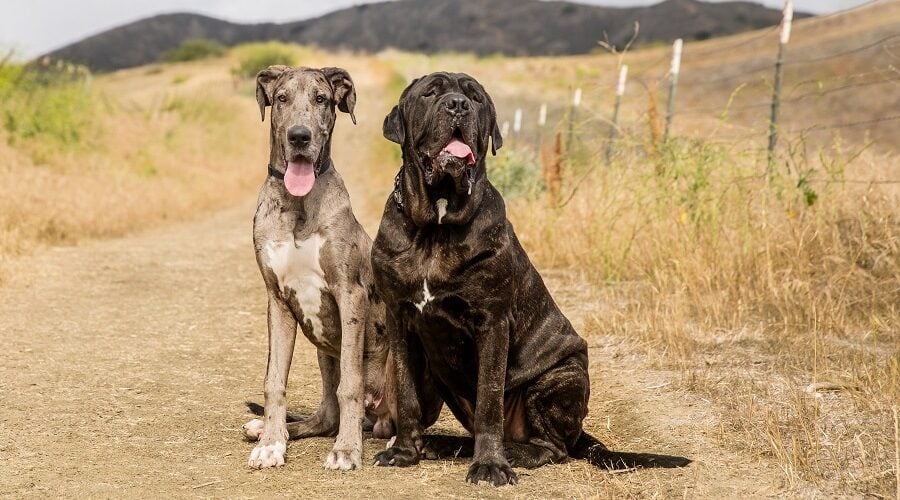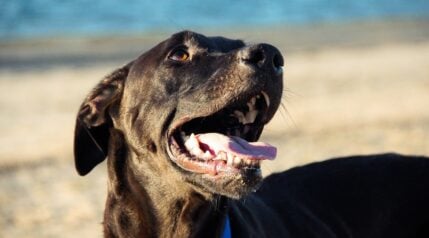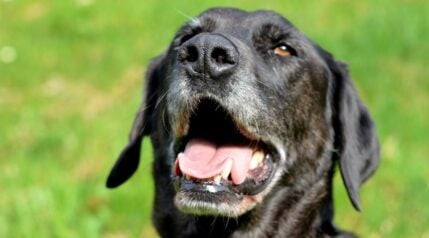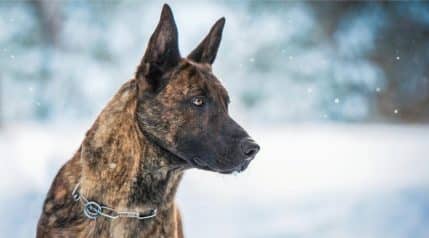If you want a dog that is going to turn heads when you walk into a room, then both the Great Dane and the English Mastiff will do exactly that! They are both in the big boy gang; big in body and big in heart.
There are some similarities between the two, but there are also some significant differences. The English Mastiff is one of the oldest dog breeds recorded in history, and the Great Dane is said to have been bred from the English Mastiff, so they share D.N.A. The biggest difference between the Great Dane and the English Mastiff is that they are on the opposite ends of the giant spectrum. The Great Dane is extremely tall and long, whereas the English Mastiff is extremely wide and heavy.
If you’re here because you’re deciding which breed might be better for you and your lifestyle, or if you’re simply curious, you will hopefully find all the information you need in this article. Whatever the outcome, if you have some spare space in your home and your heart, they will happily fill it.
Breed Comparison
Great Dane
- Height 28-32 Inches
- Weight 110-175 Pounds
- Temperament Friendly, Patient, Dependable
- Energy High
- Health Average
- Lifespan 7-10 Years
- Price $1,500 and Up
English Mastiff
- Height 27-32 Inches
- Weight 130-220 Pounds
- Temperament Sweet Natured, Loving, Docile
- Energy Low
- Health Average
- Lifespan 6-10 Years
- Price $1,000 - $1,500
Breed History
Not only is it interesting to delve a little deeper into a dog’s past, but it is also important to understand their history. Not only will it help you to understand them better but it may also tell you a bit more about what they need.
Great Dane

The history of the Great Dane is a little perplexing. The name ‘Great Dane’ originated in Denmark, although the breed itself has absolutely nothing to do with Denmark. It is believed that a Danish man suggested the Danish climate turned the Greyhound breed into the Great Dane, nicknaming them the ‘Grand Danois,’ which translates into ‘Big Danish,’ but he is now more famously known as the Great Dane. However, these dogs were born and bred in Germany.
The Great Dane is believed to have been bred from Mastiff-type dogs thousands of years ago (they are also known as the German Mastiff) and in particular the English Mastiff, with a bit of Irish Wolfhound and Irish Greyhound thrown into the mix. They were originally used to hunt wild Boar due to their size and power.
After the 16th Century, they were bred by German Nobleman to be more slender in appearance and to be kept indoors as family companions. In Germany, they were known as ‘Kammerhunde,’ which translates into ‘Chamber Dog.’
They were only owned by Royalty and very rich people; the dogs were seen to be the most beautiful breed around and were often decorated by their family in velvet collars studded with jewels.
To this day they are still used as companion dogs rather than for hunting, and they have been ranked as the 16th most popular breed out of 193 breeds by the American Kennel Club (AKC). They are also popular purebreds to mix with other breeds to create designer dogs, like the Labradane.
English Mastiff

The English Mastiff originated from England, they have been around for thousands of years, first recorded in the year 55 B.C. The famous conqueror, Julias Caesar, saw the Mastiffs in battle and he described them as impressive defenders of Britain who fought alongside their masters.
The English Mastiff impressed the invaders so much that they took him back to Rome and pitched him in battle as gladiators against Lions and other tremendous animals.
Around the time of the First World War, the English Mastiff breed nearly died out in Britain because food rations meant that families couldn’t feed them (we’ll get onto how much food they need later in the article!). However, after the war, two Canadian English Mastiff puppies were shipped over to England and their numbers began to increase again.
During that time, some say Saint Bernards were used to keep the breed alive, which is why some of them still have long hair. Since then the English Mastiff has increased in popularity due to their loving nature and guarding abilities. They have been ranked as the 29th most popular breed in America today.
Their sweet disposition has made them a breeder favorite when crossing over with other purebred dogs, like the mastiff lab mix, the American Mastiff (which has 1/16th of Anatolian shepherd), and have at times been crossbred with Pitbulls.
Appearance

Despite having what seems like hundreds of names the Great Dane can only be described as one thing, regal. They have a long but narrow face and often look quizzical. He is very distinct in his appearance; athletic and sleek bodied, with long legs leading up to a neck that is held high and proud.
He stands at up to 32 inches in height, but when he climbs up on his hind legs, he is often taller than a human. He weighs up to 175 pounds, and although this is no mean feat, he is much lighter than the English Mastiff.
The English Mastiff is often described by his parents as a cuddly lump! This guy is also very distinct in his appearance, but for very different reasons. He is wide, muscular, and thick and weighs up to 230 pounds. This beautiful beast stands at 30 inches in height and upwards. He has a large head with a short muzzle. His skin is often loose and wrinkly, which some would describe as chubby rolls, but really, who cares?!
Large drop-down ears fall naturally from the Great Dane’s side, just below his cheek. Originally his ears were cropped so that they wouldn’t be torn by Boar’s husks while hunting them. It is still common for the Great Dane to have his ears cropped to maintain his noble look, despite much controversy on the practice. He also frequently sports incredibly long pointy ears.
The English Mastiff ears are kept natural more so than the Great Dane, and they are similar in appearance to that of the Great Dane’s natural ears.
Appearance is the biggest difference between these two gorgeous breeds. If it is a taller and more athletic dog you’re after then the Great Dane is the winner, but if you are after a larger beefier boy, then the English Mastiff wins paws down.
Temperament

Even though the Great Dane and the English Mastiff were the original hunters, neither of them would be much of a hunting companion nowadays compared to their forefathers. Both breeds would much prefer to laze about for the day and chill with their family rather than be out hunting.
These breeds are best described as the gentle giant in the dog kingdom, but the parents of each would claim their pooch to be the winner of this title (neither of which would be wrong!). Both are equally as happy to sit on your lap as the other, so either way, be prepared to be squashed.
They are very affectionate and loving with their family, and both are known to be patient and this trait makes them great with kids of all ages. Remember that you should always supervise young children with dogs of this size however much a caring canine they may be.
A difference in their temperament is that the English Mastiff is rather protective of his family, and he can be wary of strangers. It may take time for this dude to accept strangers into his pack, but it is definitely worth your efforts when he does welcome you.
In comparison, the Great Dane is a seriously sociable pup who will play with anyone who will brave his size. Don’t mistake his playfulness for foolishness; however, if he senses that his family is in danger, he will be quick to protect his family, and his bark is enough to scare anyone off!
The Great Dane is known to be a class clown, he is quite clumsy and will often lose control of those long limbs of his. The English Mastiff can be quite clumsy and wobble into things, but this is more because of his sheer size. The English Mastiff is often described as a serious pup, but a cuddly kinda serious!
Exercise

Both the Great Dane and the English Mastiff have medium energy and exercise levels. They will both require between 30 and 60 minute walks a day, and this is where their similarity in exercise ends.
After the daily exercise or walks are done, the English Mastiff would happily lay about with his family and catch as many snoozes as he can. Despite pretending to be asleep, or trying to convince you he doesn’t need exercise, he does! He needs to get his heart pumping at least once a day in order to keep himself healthy and in tip-top condition.
The Great Dane is much more playful and requires more mental stimulation. He needs attention throughout the day, and interactive games are preferred. Frisbee and playing tug of war is a sure favorite to keep him occupied. If you do have to leave him to his own devices for a while, then treat-filled puzzle toys are always a winner with this guy as he can be known to suffer from separation anxiety.
You should be cautious of over-exercising both the breeds up until the age of at least 18 months due to the fast rate at which their bodies grow, as this can damage their bone and joint growth. Ensure walks are kept short and jumping off from heights such as the bed or garden walls are kept to an absolute minimum, if at all.
Training

These guys are quite different in their trainability. The Great Dane is slightly over average when it comes to his intelligence, and I’m afraid to say that the English Mastiff’s intelligence is slightly under average. What this means is that the Great Dane is much easier to train than the English Mastiff and picks up commands quicker.
Due to the English Mastiff’s previous employment in the guarding sector, it is even more important to socialize him from a young age. If you don’t mix him with other humans and animals outside of the family unit, his wariness of strangers may turn into over-protectiveness. Be sure to make every interaction positive and treat him with small treats and plenty of verbal praise.
For sure, training an English Mastiff is not for the novice dog owner. Additionally, the Mastiff also does things in his own time, also known as ‘Mastiff time,’ so if he doesn’t feel like giving you paw today then he probably won’t. Don’t be disgruntled with this, keep being consistent with your training, and although he may not do it every time, he will still be a well-mannered pooch. If you are struggling, obedience training with a dog behavioral therapist may be the answer.
Health

Both of these pooches are quite healthy considering their size. On average, both of these pups can live to the age of 10. This is quite young in terms of canine lifespans so this is something to consider.
As they are big dogs, they are both prone to Elbow and Hip Dysplasia, which is an abnormality in the joint formation which can eventually lead to crippling arthritis. Bone Cancer, also known as Osteosarcoma, is common in both breeds too. Lumps and lameness are the most prominent symptoms of this.
They are both also susceptible to Gastric Torsion, which is where their stomach twists if they eat a meal immediately before or after exercise. Symptoms include a swollen belly, retching but not vomiting, and other distress signs such as panting or restlessness. Your pooch needs to get to the vet as soon as possible if he displays any of these symptoms as they can be life-threatening.
The Great Dane is also prone to Wobbler’s Syndrome, which is where the affected dog shakes from around the age of 1 ½ year and he is one of the few breeds to get this. Symptoms include odd walking, lack of coordination, and lethargy. If you think your Great Dane is being more than just a bit clumsy, then the earlier you can get him seen by a veterinarian, the better his prognosis will be.
Nutrition

Earlier we mentioned that the English Mastiff nearly became extinct because families could not afford to feed in him during the First World War. The reason they couldn’t feed him is that the English Mastiff eats around eight cups of food a day and everyone was on food rations!
The Great Dane eats half of that at four cups of food a day. Not only does that equate to a big difference in kibble, but it also equates to a lot more money if you need to feed an English Mastiff.
Because both of these guys are big dogs that grow quickly, they need a top-quality diet to ensure they are getting all the nutrition their body needs. Be warned though, the English Mastiff likes a treat or two and he can easily pile on the pounds. You need to monitor the treats he gets otherwise he can become obese.
Grooming

The Great Dane and the English Mastiff are similar in their grooming needs, and they don’t require much more than your average pooch. They would benefit from being brushed two to three times a week to keep them looking healthy and to remove any dead hair.
The English Mastiff produces more coat oil than your average pooch, and this means that they can be prone to a stronger dog odor. Most dogs require a bath every four to six weeks, this guy could benefit from a bath every four weeks.
As the Great Dane has much shorter hair, he will do okay to be bathed every six weeks. Be sure not to overdo it on the bathing or you’ll risk damaging their natural coat oils, which can lead to skin problems. If the bathing is still not resolving the Mastiff’s stronger doggy smell, then doggy sprays and perfume can be bought from your local store.
Another grooming-related issue to be aware of, but one you can do absolutely nothing about is the drool. Both these breeds are dribble monsters, so if you don’t want a slobbery sidekick in your house then stay clear of these two guys (unfortunately, bibs will not work here!).
Puppy Price

Both the Great Dane and the English Mastiff are, on average, the same price at around $1,500 from a reputable breeder. Buying a pup from a reputable breeder means that you can ask for and check on his parent’s health to ensure you are buying a healthy pup. Additionally, you are getting a lot of dog for your buck, so don’t be tempted to buy him from a puppy mill as you will undoubtedly spend much, much more on vet bills in the long run.
If you are swaying toward the English Mastiff, remember to consider his monthly food bills, as you definitely won’t get away with putting this boy on food rations! Keep in mind that everything is more expensive with a Mastiff, not just puppy costs! Mastiff-sized dog beds and bigger dog toys are just two of the things that you’ll be spending more money on!
Final Thoughts
There is no denying that both of these breeds are beautiful pups with beautiful personalities. If it’s a snuggle buddy you’re after, look no further than these two as they both love to hop on the sofa with their master.
They are very different in appearance; the Great Dane is very tall and athletic and the Mastiff is wide and muscular. They are similar in that they love their family, they are sociable and great with children. The Mastiff makes for a better guard dog as he is warier of strangers, but they will both protect their pack when needed.
So, whether you want a tall giant or a wide giant, both of these gentle souls have a whole lotta love to give!





